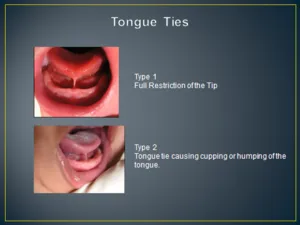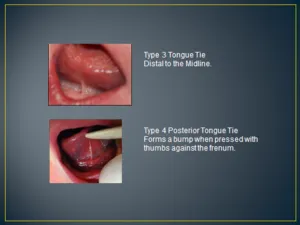- Are you a mother who has difficulty breastfeeding her baby?
- Does your baby look like it has a tongue tie or a lip tie?
- What problems can a tongue tie cause?
- What are the advantages of a laser frenectomy with a baby?
- Are you looking for a laser frenectomy in Adelaide?
We'll keep reading!
If your baby has trouble with feeding, colic, or gas, the attachments of the lip or tongue can be the problem. Upper lip or tongue ties can have an enormous effect on your baby's ability to latch.
The lip is attached to the gum by tissue called the frenum. A frenectomy or frenotomy (different professions have different words for the same procedure) is the cutting and removal of this tissue to improve the feeding of the baby and improve breastfeeding for the mother.
How do you do a frenectomy with a laser on a baby?
First, we have a consultation and discuss whether this type of procedure is going to make a difference for your baby. There are several different types of tongue ties and we need to assess the severity. Upper lip ties also can affect the ability of the baby to latch onto the breast, so this is assessed at the same time.
Then we swaddle the baby in a wrap similar to going to sleep, we want to make sure the arms and legs are kept still for the procedure. Then the baby is given to us for 5 mins to complete the procedure. We give a cotton roll soaked in sugar to help identify the lip movements and to provide some slightly improved pain tolerance during the procedure. No anesthetic is used because the laser removes the tissue with low pain to the baby. It also helps us to make sure the baby can feed immediately after the procedure. This helps us make sure that we have gained improvement with the frenectomy. Most babies go back to sleep after they have fed in our office.
Below is further information for those parents who want more detailed information with references.
Effects of Lip Ties
- Failure of the upper lip to flange over the breast.
- Shallow latch which can be more uncomfortable.
- Large space between upper front teeth that can be difficult to close with orthodontics in later life.
- Movement of upper front teeth labially (outwards)
- Higher decay rate due to difficulty in brushing and longer time for food to remain on teeth (due to anatomy)
Effects of Tongue Ties
- Roughly 50% of adults with altered tongue ties will have speech defects in adults eg lisping (Marchesan 2004).
- Frenectomies in adults result in improved tongue posture, mobility, and function (Marchesan et al, 2012)
- Prevalence is up to 5% of population (Klockars 2007)
- Tongue ties are implicated in modified craniofacial development. Upper and lower jaw growth is dependent on the ability of the tongue to operate efficiently and effectively.
- Sleep apnea has been linked to impaired tongue function
Posterior Tongue Ties
- The frenum holds the center of the tongue causing the posterior tongue to hump up.
- The baby can not extend the tongue to remove it from the back of the mouth, therefore causing gagging or appears to be reflux. The release of the tongue may lead to the elimination of gagging and thus no reflux.
- Waiting until after the frenum is revised may reduce the causes of reflux and need for medication.
Criteria Indicating the possible need for Frenectomy- Infant
- No latch
- Unsustained latch
- Slides off the nipple
- Prolonged feeds that may not be satisfying
- Falls asleep on the breast
- Gumming or chewing on the nipple
- Poor weight gain/failure to thrive
- Unable to hold the dummy
Criteria Indicating the possible need for Frenectomy – Mother
- Creased/blanched/flattened nipples after feeding
- Cracked/bruised nipples causing the mother to give up
- Bleeding nipples
- Severe Pain with latch
- Incomplete breast drainage
- Plugged ducts
- Mastitis.
Effects of Frenectomies
- Ultrasound evidence of breastfeeding (Uni WA studies) shows less compression of the tip or the base of the nipple after frenectomy.
- Mothers report in our practice an immediate sensation of feeding that it is ‘more comfortable’, less leakage, clicking, noise, improved drainage.
- Hogan et al 2005 treated half tongue-tied babies with frenectomies and left the other half to improve on their own. 95% of frenectomies improved and fed normally, only 5% self-improved!
- Stretching is done AFTER every feed for 2 weeks or until the wound is completely healed.
- The upper lip needs to be lifted up for 3 seconds towards the nose. This acts to help reduce the adhesion of the wound.
- The tongue needs to be lifted up and pushed back again for 3 seconds, this again helps to stretch the area.
- Occasional bleeding may result (especially at the 1-week mark). This is normal and shows a good stretch of the healing wound.
- The wound can be wiped with anything that you would use safely for cracked nipples. Wash hands thoroughly before stretching the wound.
Our Treatment Guidelines
- We treat the babies with staff present and parents out of the room to reduce anxiety and provide a safer treatment area.
- Babies are wrapped/swaddled tight during the procedure so that arms and legs are kept still.
- We see a range of different patients but we do frenectomies in the chair on babies up to 6 months because they are more manageable. We wait if they are older until they are 4 for us to treat them.
- We ask parents not to feed the babies 90 minutes prior to treatment so that we can get the baby to feed after the laser treatment
- Lactation consultants are excellent monitors of the healing process and can help reinforce stretching exercises.
- Some of the patients we see are quite old (6 months) and poor feeding habits over a lifetime have been established. It is important to regain better feeding habits with a professional.



